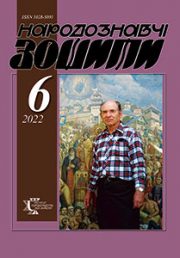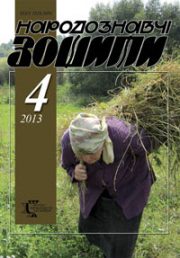The Ethnology Notebooks. 2023. № 2 (170), 372—378
UDK 94:[[061:7:077]:355.257.7=161.2](430)”1915/1918″
DOI https://doi.org/10.15407/nz2023.02.372
HERUS Lyudmyla
- ORCID ID: https://orcid.org/0000-0002-5931-3816
- Doctor of Sciences in History,
- Сandidate of Аrts(Ph. D), Head of Department,
- The Institute of Ethnology of the National Academy
- of Sciences of Ukraine,
- Departmentof Folk Art,
- 15, Svobody Avenue, 79000, Lviv, Ukraine,
- Contacts: e-mail: ludmilagerus@gmail.com
Abstract. Introduction. Folk art is a phenomenon of material and spiritual culture that develops on the basis of heredity and preservation of tradition and reveals an ethnic character. In Ukraine, it held a special place and is one of the defining ways of being and establishing the national idea.
Article purpose — to consider the activity of the «Ukrainian Cooperative Craft Union» 1915—1918 of the First World War, which was created by measures of the Union for the Liberation of Ukraine in Rastatt camp (Germany) from Ukrainian prisoners who were in the tsarist army and was based on the traditions of Ukrainian decorative and applied art; to show Mykhailo Paraschuk’s contribution to the creation and development of the «Ukrainian Cooperative Craft Union» work; to find out the influence of Ukrainian decorative and applied art on the formation of national consciousness and patriotic civic position of Ukrainian prisoners of war.
The objec to researc his aspects of national cultural and educational work among imprisoned Ukrainian soldiers held in the Rastatt camp and the subject is organizational activities and artistic practices of the «Ukrainian Cooperative Craft Union».
The article source base compiled photos from the archive of art critic Oleh Sydor and facts from Mykhailo Paraschuk’s diary.
Conclusion. «Ukrainian Cooperative Craft Union» became a powerful weapon in the formation of national consciousness and patriotic public position of Ukrainian prisoners of war. This was made possible due to an effective system of cultural and artistic education and upbringing, a deep understanding of the traditions and synthetic nature of folk art, its role in the being of Ukrainians, as well as the professional knowledge (expertise) and pedagogical skill of its leader Mykhailo Paraschuk. Evidence of the high national self-awareness of the prisoners was the establishment of charitable funds, the funds of which went to support national educational work in the camps, to create monuments to those who died in captivity, as well as to all-Ukrainian humanitarian goals. Thousands of captured Ukrainians, having realized the Ukrainian national idea, after returning to their homeland took an active part in the Ukrainian revolution of 1917—1920.
Keywords: folkart, cultural and educational work, camp, prisoner of war, Rastatt, Union for the Liberation of Ukraine.
Received 25.02.2023
REFERENCES
- Herus, L. (2019). Folk decorative and applying art role in the cultural consolidation of ukrainians in crisis period. The Ethnology notebooks, 1 (145), 4—12 [in Ukrainian].
- Terletsky, O. (1919). Ukrainians in Germany 1915—1918: the history of the Ukrainian community in Rastat (Vol. 1). Kyiv; Leipzig [in Ukrainian].
- Sribnyak, I. (2014). Art centers of Ukrainian prisoners in the Rastat camp (second half of 1915—1916). Bulletin of Taras Shevchenko Kyiv National University. Seriia «History», 5 (123), 59—62 [in Ukrainian].
- Sribnyak, I. (2014). National-organizational and cultural-educational activity of captured Ukrainians in the Rastatt camp (Germany) in 1915—1917. Severyan Chronicle, 6 (120), 309—324 [in Ukrainian].
- Sribnyak, I. (2017). Creation and activity of the Committee of Cultural Assistance to Ukrainians in Germany in the Rastatt camp (second half of 1918). Kyiv historical studios, 1 (4), 3—8 [in Ukrainian].
- Stepovyk, D. (1994). Sculptor Mykhailo Paraschuk: life and creativity. Edmonton; Toronto; Kyiv [in Ukrainian].
- Oniskiv, M., & Khavarivskyi, B. (2003). Ukrainian Mykhailo Paraschuk: Peer of the Bulgarian will, Sufferer of our fate. Ternopil [in Ukrainian].
- Herus, L., & Paska, B. (2020). Parashchuk Mykhailo Ivanovich. Western Ukrainian People’s Republic 1918—1923. Encyclopedia: To the 100th anniversary of the formation of the Western Ukrainian People’s Republic (Vol. 3: P—S, pp. 68—70). Ivano-Frankivsk; Lviv: Manuscript [in Ukrainian].
- (1989). Decorative plate from Mykhailo Paraschuk’s pottery workshop-school. 1918, Rastatt (from the collection of M. and M. Labunki). Notes on art(Vol. 29,рp. 34).Philadelphia [in Ukrainian].
- (1917). News in the camp. Enlightenment: the magazine of the prisoners of the community of the «Independent Ukraine», 8 (73).







